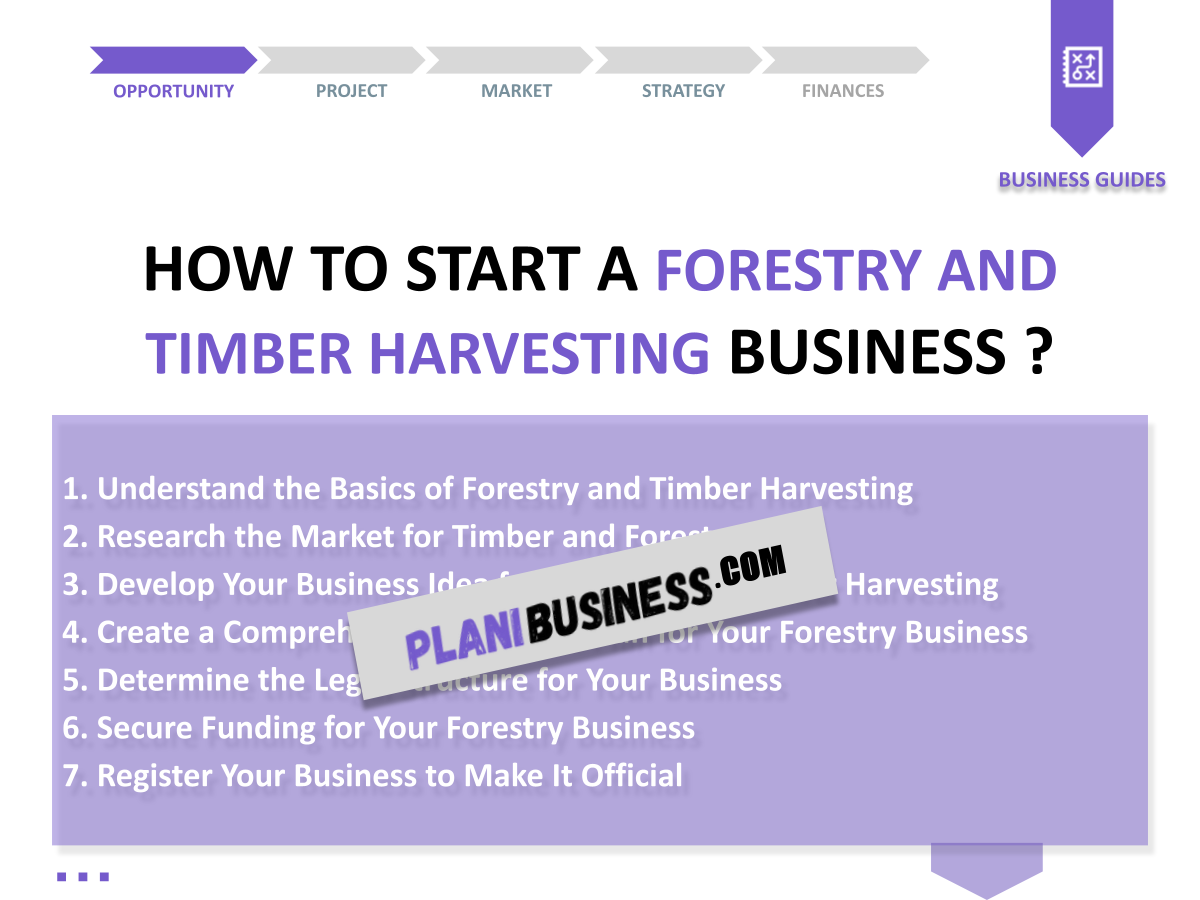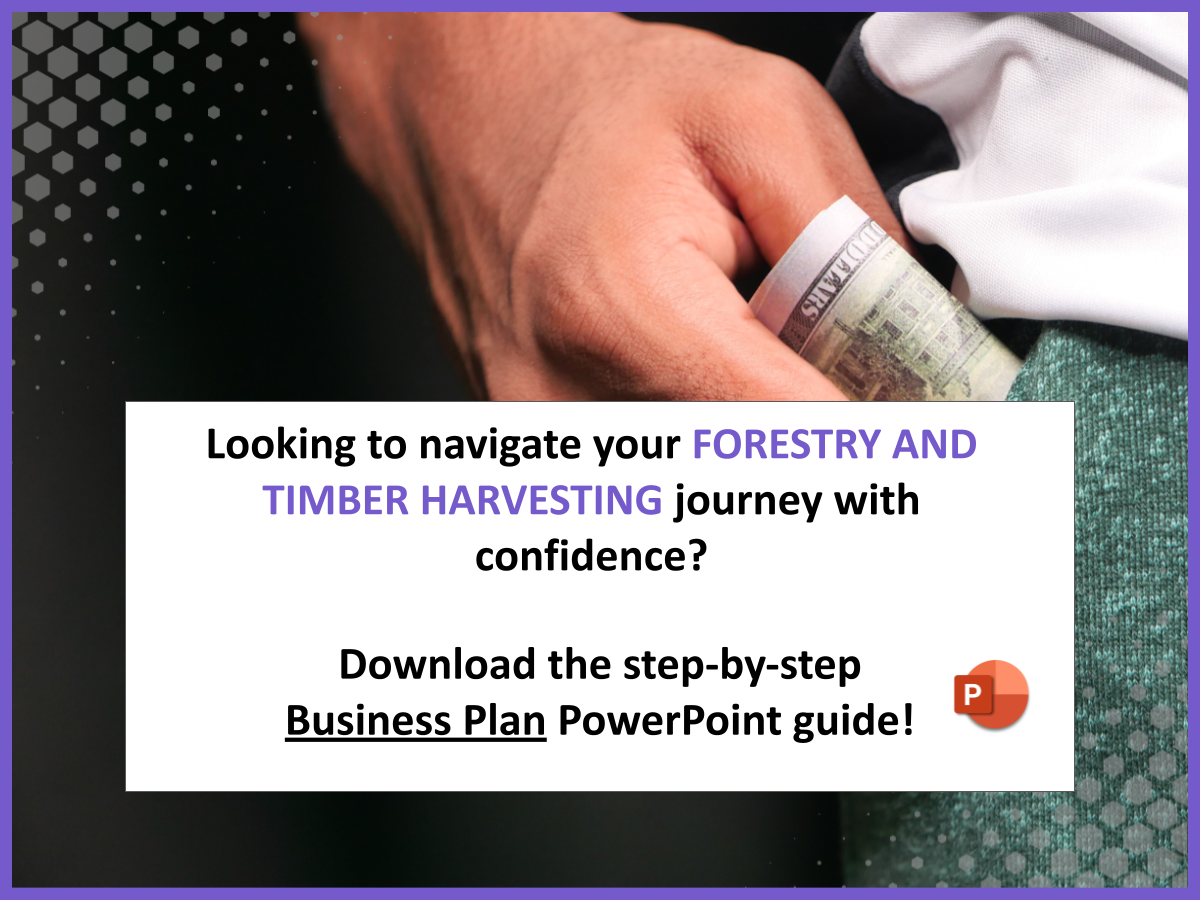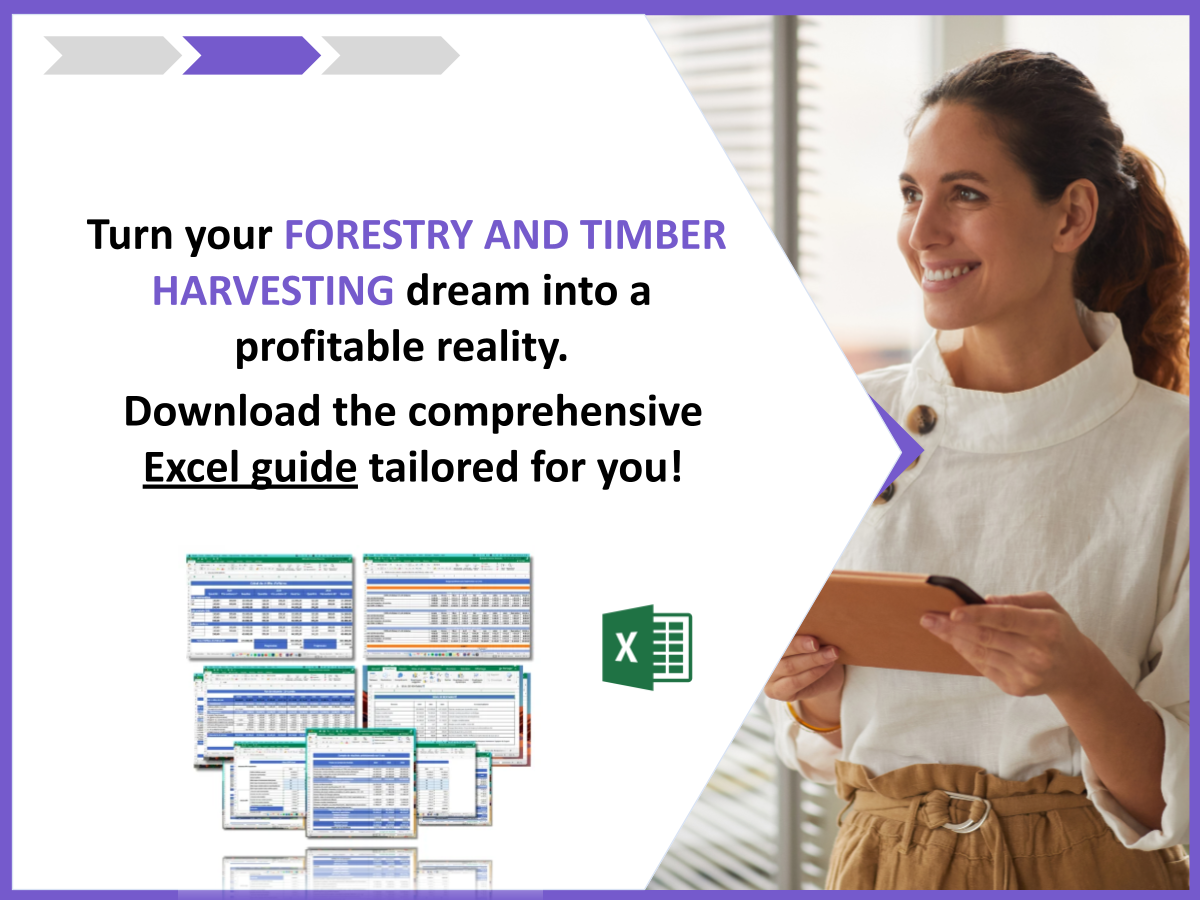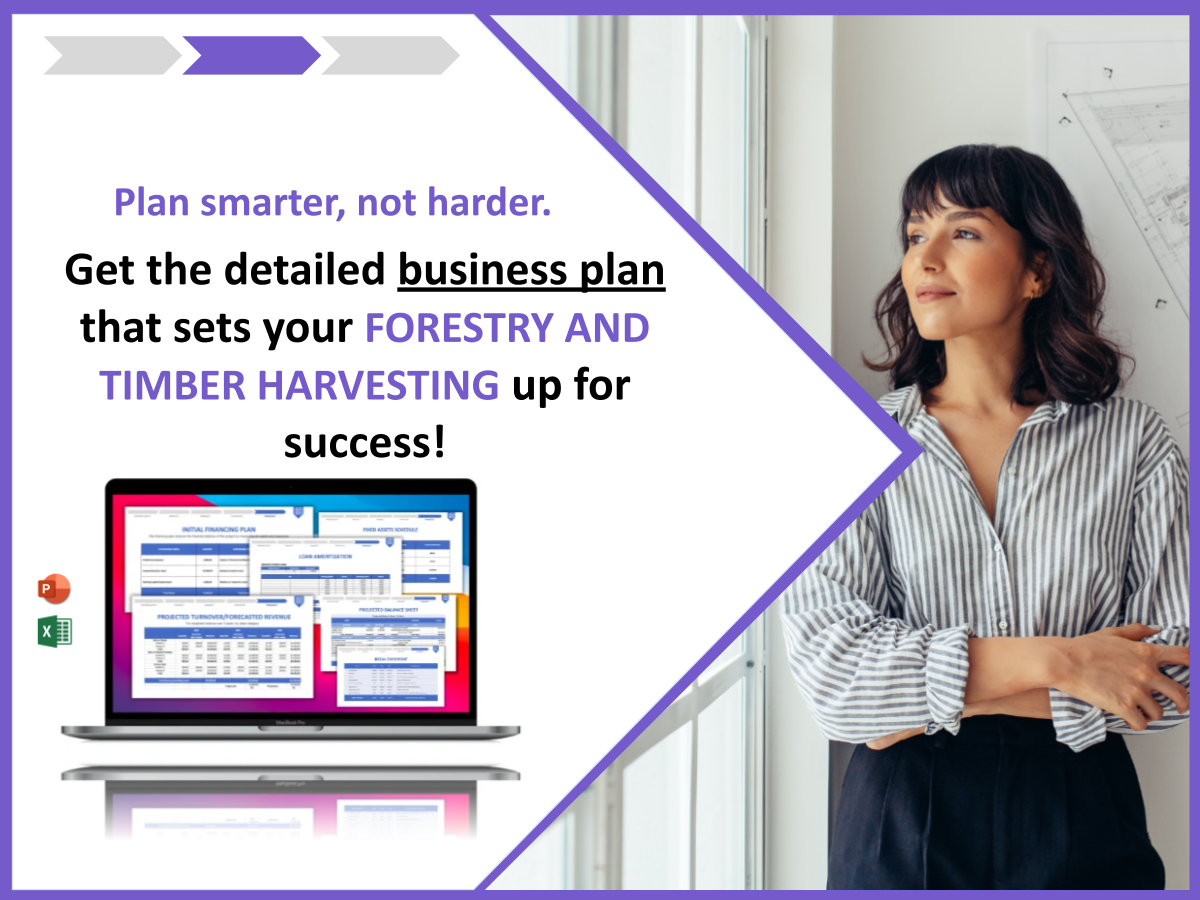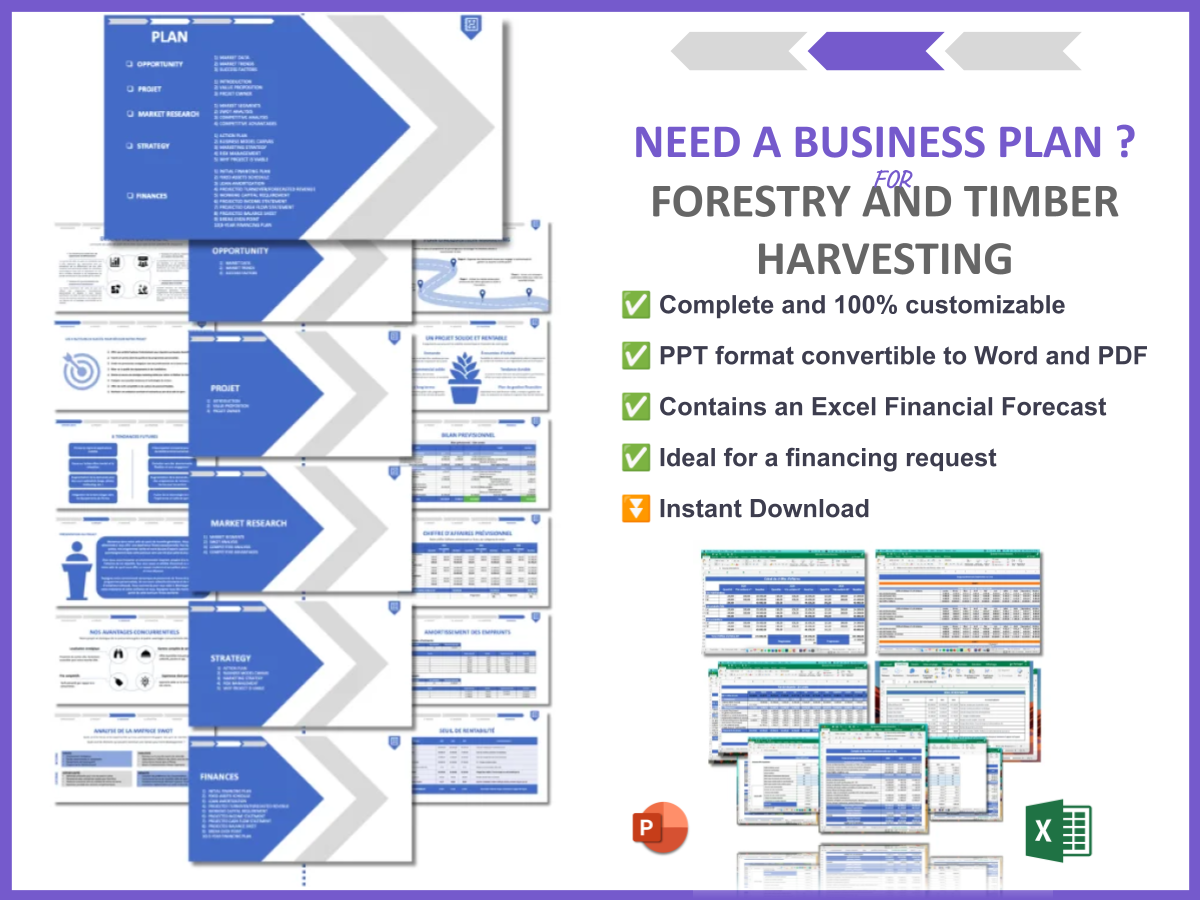Are you considering launching your own venture in the forestry industry? You’re not alone! The demand for sustainable timber and forestry management is on the rise, making it an exciting time to get involved. Starting a forestry and timber harvesting business is not just about cutting down trees; it’s about understanding the ecosystem, managing resources responsibly, and creating a sustainable future. In this article, we’ll explore essential steps to guide you through the process of establishing your own business in this vital sector.
- Understanding the basics of forestry and timber harvesting
- Researching the market for timber and forestry
- Developing your business idea
- Creating a comprehensive business plan
- Determining the legal structure of your business
- Securing funding and financial resources
1. Understand the Basics of Forestry and Timber Harvesting
To successfully start a forestry and timber harvesting business, it’s crucial to comprehend the foundational concepts involved. Forestry encompasses the management and cultivation of forests, while timber harvesting refers to the process of cutting trees for commercial purposes. This industry plays a pivotal role in our economy and environment.
Here are some key aspects to consider:
- Forest Ecology: Understanding the relationships between trees, wildlife, and the environment is essential for sustainable practices.
- Timber Types: Familiarize yourself with various types of timber, such as hardwoods and softwoods, and their specific market demands.
- Sustainable Practices: Learn about environmentally responsible harvesting techniques that help preserve forest ecosystems.
For instance, did you know that forests cover approximately 31% of the Earth’s land area? They not only provide timber but also contribute to biodiversity and climate regulation. This statistic emphasizes the significant responsibility you’ll carry as a forestry business owner.
2. Research the Market for Timber and Forestry
Conducting thorough market research is a vital step before launching your business. Understanding current trends, consumer demands, and potential competitors will position you for success. Ask yourself: What types of timber are in high demand? How do seasonal changes affect timber prices?
Here are some effective strategies for conducting market research:
- Analyze Industry Reports: Look for data on timber prices and market trends from reputable sources.
- Engage with Local Forestry Associations: These organizations can provide valuable insights and networking opportunities.
- Survey Potential Customers: Gathering feedback from potential clients can help tailor your services to meet their needs.
To better understand market demand, consider creating a table that compares different timber types and their average prices:
| Timber Type | Market Demand | Average Price per Unit |
|---|---|---|
| Oak | High | $X |
| Pine | Medium | $Y |
| Maple | Low | $Z |
This information will help you identify the best opportunities in the market and shape your business strategy accordingly.
3. Develop Your Business Idea for Forestry and Timber Harvesting
Creating a unique business idea is a fundamental step in your journey to start a forestry and timber harvesting business. This involves identifying a niche that not only aligns with your interests but also addresses market demands. Ask yourself: What unique services can I offer? Will I focus on sustainable practices, specialty timber types, or perhaps a combination of both?
Consider the following approaches to refine your business idea:
- Identify Your Passion: Think about what aspects of forestry excite you the most. Is it the environmental impact, the business side, or perhaps the hands-on work with timber?
- Research Competitors: Analyze what other businesses are doing in your area. Look for gaps in the market that you could fill.
- Visualize Your Concept: Create a mind map to connect your ideas and explore how they relate to each other. This can help clarify your vision and highlight potential challenges.
For example, if you notice a growing demand for reclaimed wood, you might consider specializing in sourcing and processing reclaimed timber. This not only meets market needs but also supports sustainability.
4. Create a Comprehensive Business Plan for Your Forestry Business
A solid business plan is your blueprint for success in the forestry industry. It outlines your goals, strategies, and the steps you’ll take to achieve them. A well-prepared plan is also essential for securing funding from investors or banks.
Your business plan should include several key components:
- Executive Summary: A brief overview of your business concept and goals.
- Market Analysis: Insights into your target market, competitors, and industry trends.
- Marketing and Sales Strategies: How you plan to attract and retain customers.
- Financial Projections: Detailed forecasts for revenues, expenses, and profits.
To help you get started, consider using a table to outline your financial projections:
| Year | Projected Revenue | Projected Expenses | Net Profit |
|---|---|---|---|
| Year 1 | $X | $Y | $Z |
| Year 2 | $A | $B | $C |
| Year 3 | $D | $E | $F |
Additionally, I recommend checking out this business plan template for Forestry And Timber Harvesting. It’s super detailed and can save you a ton of time! By including these elements in your business plan, you’ll be well-prepared to present your ideas to potential investors and set your business on a path to success.
5. Determine the Legal Structure for Your Business
Choosing the right legal structure is a critical decision when you start a forestry and timber harvesting business. The structure you select will affect your taxes, liability, and overall management of the business. Common options include sole proprietorships, partnerships, and limited liability companies (LLCs).
Here’s a brief overview of each structure:
| Legal Structure | Pros | Cons |
|---|---|---|
| Sole Proprietorship | Simple to set up, full control | Unlimited personal liability |
| Partnership | Shared responsibility, diverse skills | Potential for disputes among partners |
| LLC | Limited liability protection | More paperwork and higher costs |
When deciding which structure suits your forestry and timber harvesting business best, consider factors such as the number of owners, the level of acceptable risk, and your long-term business goals. Consulting with a legal expert can help clarify which structure aligns with your specific needs and circumstances.
6. Secure Funding for Your Forestry Business
Funding is often one of the most significant hurdles when starting a new business. To successfully launch your forestry and timber harvesting business, you’ll need to explore various funding options. These can include personal savings, bank loans, grants, and private investors.
Here are some strategies to consider when seeking funding:
- Prepare a Solid Business Plan: Investors and lenders want to see a clear plan detailing how you’ll use the funds and how you plan to generate revenue.
- Research Grants: Look for grants specifically aimed at forestry or sustainable agriculture, which can provide non-repayable funds.
- Network with Investors: Attend industry conferences and workshops to meet potential investors who are interested in sustainable forestry.
Additionally, consider creating a budget that outlines your startup costs, operational expenses, and projected revenues. This will help you present a compelling case to potential investors. Here’s a simple example of a budget outline:
| Expense Category | Estimated Cost |
|---|---|
| Equipment | $X |
| Licenses and Permits | $Y |
| Operational Costs | $Z |
By being prepared and informed, you’ll increase your chances of securing the necessary funding to launch your forestry business successfully.
7. Register Your Business to Make It Official
Once you’ve determined your legal structure and secured funding, the next step is to register your business. This is a crucial step in the process of starting a forestry and timber harvesting business, as it makes your venture official and compliant with local regulations.
Here’s a step-by-step guide to help you through the registration process:
- Choose a Business Name: Select a unique name that reflects your business values and services. Ensure it’s not already in use by checking local business registries.
- File the Necessary Paperwork: Depending on your legal structure, you may need to file Articles of Incorporation or a DBA (Doing Business As) form.
- Register for Taxes: Obtain an Employer Identification Number (EIN) from the IRS if you plan to hire employees or operate as a corporation or partnership.
Additionally, remember to check if your state requires any specific permits for operating a forestry business. This can include harvesting permits or environmental clearances. Taking these steps will ensure that your business operates legally and avoids any potential fines.
8. Obtain Necessary Licenses and Permits
Every forestry and timber harvesting business requires specific licenses and permits to operate legally. Obtaining these permits is essential for complying with local, state, and federal regulations.
Here are some common licenses and permits you may need:
- Harvesting Permits: These are often required to ensure sustainable logging practices.
- Environmental Clearances: You may need to demonstrate that your operations will not adversely impact the environment.
- Safety Certifications: Compliance with safety regulations is crucial, especially when operating heavy machinery.
To keep track of what you need, consider creating a checklist:
- Research local regulations regarding timber harvesting.
- Contact local forestry departments for information on required permits.
- Prepare necessary documentation and submit applications as needed.
By ensuring that you have all the required licenses and permits, you’ll be setting your forestry and timber harvesting business up for success and avoiding any legal complications down the road.
9. Set Up Financial Management Systems for Your Business
Effective financial management is crucial for any successful forestry and timber harvesting business. Properly tracking your income, expenses, and profits will not only help you maintain financial health but also prepare you for tax season and potential audits.
Here are some essential steps to set up your financial management system:
- Choose Accounting Software: Invest in reliable accounting software tailored for small businesses. Options like QuickBooks or FreshBooks can simplify invoicing, expense tracking, and financial reporting.
- Establish a Budget: Create a detailed budget that outlines your expected income and expenses. This will help you stay on track and make informed financial decisions.
- Open a Business Bank Account: Keep your personal and business finances separate by opening a dedicated business bank account. This will make it easier to manage your cash flow and maintain accurate records.
Additionally, consider hiring a financial advisor or accountant to help you manage your books effectively. They can provide valuable insights and ensure you’re meeting all tax obligations.
To give you an idea of potential expenses, here’s a simple example of a budget outline for a forestry and timber harvesting business:
| Expense Category | Estimated Monthly Cost |
|---|---|
| Equipment Leasing | $X |
| Salaries | $Y |
| Insurance | $Z |
By establishing a solid financial management system, you’ll be well-prepared to navigate the financial aspects of your business effectively.
10. Establish Your Brand Identity for Your Forestry Business
Your brand identity is how your forestry and timber harvesting business is perceived by the public. A strong brand can differentiate you from competitors, build trust with customers, and create a loyal following.
Here are some steps to help you establish a memorable brand identity:
- Develop a Unique Logo: A professional logo should reflect your business values and be easily recognizable. Consider hiring a graphic designer to create a visually appealing logo.
- Choose a Color Scheme: Select colors that evoke the emotions you want associated with your brand. For example, greens and browns can represent sustainability and nature.
- Create a Tagline: A catchy tagline can communicate your mission and values in just a few words. Make it memorable and relevant to your services.
Furthermore, consistency is key when it comes to branding. Ensure that your logo, colors, and messaging are consistent across all platforms, including your website, social media, and marketing materials.
Engaging with your audience through social media and community outreach can also enhance your brand identity. Share valuable content related to forestry practices, sustainability, and industry news to position yourself as an expert in your field.
By focusing on your brand identity, you’ll create a strong foundation for your forestry and timber harvesting business that resonates with customers and stands the test of time.
11. Develop a Professional Website for Your Business
In today’s digital landscape, having a professional website is crucial for your forestry and timber harvesting business. Your website serves as your online storefront, providing potential customers with essential information about your services and expertise.
Here are some key elements to consider when developing your website:
- User-Friendly Design: Ensure that your website is easy to navigate and visually appealing. A clean layout with clear calls-to-action will help visitors find what they need quickly.
- Mobile Optimization: With an increasing number of users accessing websites via mobile devices, ensure your site is responsive and looks great on all screen sizes.
- Quality Content: Create informative and engaging content related to forestry practices, timber types, and sustainability. This not only showcases your expertise but also helps improve your search engine rankings.
Consider incorporating a blog section where you can share updates, tips, and insights related to the forestry industry. This will not only establish you as an authority but also attract organic traffic to your site.
Lastly, don’t forget to optimize your site for search engines by using relevant keywords throughout your content. This will help potential customers find you when searching for forestry and timber harvesting services online.
12. Market and Advertise Your Forestry Business
Here are some marketing strategies to consider:
- Social Media Marketing: Utilize platforms like Facebook, Instagram, and LinkedIn to promote your services, share industry news, and engage with your audience.
- Local Advertising: Consider advertising in local newspapers, magazines, or community boards. This can help you reach potential customers in your area.
- Networking: Attend industry conferences, trade shows, and local events to connect with other professionals and potential clients. Building relationships can lead to valuable referrals.
Additionally, consider creating promotional materials such as brochures or business cards that highlight your services and expertise. These can be distributed at local events or shared with potential clients during meetings.
By employing a mix of online and offline marketing techniques, you’ll maximize your exposure and increase your chances of attracting clients to your forestry and timber harvesting business.
13. Assemble Your Team for Your Business
As your forestry and timber harvesting business grows, you may need to hire additional staff to help manage operations and meet customer demands. Building a skilled team is essential for navigating challenges and driving your business forward.
When assembling your team, consider the following:
- Identify Key Roles: Determine the positions you need to fill based on your business operations. This may include roles in forestry management, equipment operation, sales, and administration.
- Look for Experience: Seek candidates with backgrounds in forestry, environmental science, or business management. Experienced team members can bring valuable insights and skills to your operations.
- Provide Training: Once you have hired your team, consider implementing a training program to ensure all employees are knowledgeable about sustainable practices, safety regulations, and company policies.
Moreover, fostering a positive work environment can enhance employee morale and productivity. Encourage open communication and collaboration among team members to create a cohesive unit that works towards common goals.
By building a strong team, you’ll be well-equipped to handle the challenges of running a forestry and timber harvesting business and ensure its long-term success.
Conclusion
Starting a forestry and timber harvesting business can be a fulfilling and profitable venture, especially when approached with thorough planning and a commitment to sustainability. By following the steps outlined in this article, you can establish a solid foundation for your business, from understanding the basics of forestry to developing a strong brand identity.
As you embark on this journey, remember that continuous learning and adaptation are key to long-term success. I encourage you to explore further resources to enhance your knowledge. For instance, check out our article on how to create a SWOT Analysis for Forestry And Timber Harvesting to understand your business’s strengths and weaknesses better. Additionally, you can learn about How to Start a Forestry And Timber Harvesting Marketing Plan? With Example to develop effective strategies for reaching your target audience.
With the right tools and strategies, you can thrive in the forestry industry and contribute positively to the environment.
FAQ
1. What are the initial steps to start a forestry business?
The first steps include researching the market, developing a solid business idea, creating a business plan, and understanding the legal requirements for operating a forestry and timber harvesting business.
2. What licenses and permits do I need for timber harvesting?
You typically need harvesting permits, environmental clearances, and safety certifications, depending on your location. It’s essential to check local regulations to ensure compliance.
3. How do I conduct market research for my forestry business?
Conduct market research by analyzing industry reports, engaging with local forestry associations, and surveying potential customers to understand demand for different timber types.
4. What legal structure should I choose for my forestry business?
Your options include sole proprietorship, partnership, or limited liability company (LLC). Each structure has its pros and cons, so consider your specific needs and consult a legal expert.
5. How can I secure funding for my forestry business?
Explore various funding options such as personal savings, bank loans, grants, and private investors. Prepare a solid business plan to present to potential lenders or investors.
6. What should I include in my business plan for forestry and timber harvesting?
Your business plan should encompass an executive summary, market analysis, marketing strategies, and financial projections to guide your business operations.
7. How can I effectively market my forestry business?
Utilize social media, local advertising, and networking opportunities to promote your services. Engaging with your audience through valuable content can also help establish your brand.
8. What is the importance of sustainable practices in forestry?
Sustainable practices are vital for preserving forest ecosystems, ensuring long-term resource availability, and meeting increasing consumer demand for environmentally friendly products.
9. How do I create a strong brand identity for my forestry business?
Develop a unique logo, choose a consistent color scheme, and create a memorable tagline that reflects your values. Ensure consistency across all platforms for effective branding.
10. What qualifications should I look for when hiring staff for my forestry business?
Look for candidates with backgrounds in forestry, environmental science, or business management. Experience and expertise in sustainable practices are also valuable assets.

